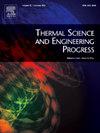Infrared thermal image detection and facial expression recognition based on genetic algorithm in sports prediction simulation: Sports thermal modeling
IF 5.1
3区 工程技术
Q2 ENERGY & FUELS
引用次数: 0
Abstract
In the field of sports, accurate evaluation of athletes’ physiological and psychological states is the key to improve training efficiency and competition results. An infrared thermal image detection and facial expression recognition system based on genetic algorithm is developed for the prediction and simulation of sports. The thermal image data of athletes in training and competition were collected by infrared thermal imager. Then feature extraction and pattern recognition are carried out on these images using genetic algorithm to identify the key thermal image features reflecting the athlete’s state. The facial expression recognition part trains the model through deep learning techniques to recognize and analyze the athlete’s facial expressions to infer their emotional and psychological state. Finally, these data are integrated into a sports thermal model to predict athlete performance by simulating different training and competition scenarios. The experimental results show that the infrared thermal image detection system based on genetic algorithm can accurately identify the key physiological indicators of athletes, and the facial expression recognition system can successfully identify the emotional changes of athletes in different situations. By applying this data to sports thermal models, we are able to effectively simulate and predict athlete performance under specific training and competition conditions. The results of model prediction have high correlation with the actual performance, which verifies the effectiveness and practicability of the system.
求助全文
约1分钟内获得全文
求助全文
来源期刊

Thermal Science and Engineering Progress
Chemical Engineering-Fluid Flow and Transfer Processes
CiteScore
7.20
自引率
10.40%
发文量
327
审稿时长
41 days
期刊介绍:
Thermal Science and Engineering Progress (TSEP) publishes original, high-quality research articles that span activities ranging from fundamental scientific research and discussion of the more controversial thermodynamic theories, to developments in thermal engineering that are in many instances examples of the way scientists and engineers are addressing the challenges facing a growing population – smart cities and global warming – maximising thermodynamic efficiencies and minimising all heat losses. It is intended that these will be of current relevance and interest to industry, academia and other practitioners. It is evident that many specialised journals in thermal and, to some extent, in fluid disciplines tend to focus on topics that can be classified as fundamental in nature, or are ‘applied’ and near-market. Thermal Science and Engineering Progress will bridge the gap between these two areas, allowing authors to make an easy choice, should they or a journal editor feel that their papers are ‘out of scope’ when considering other journals. The range of topics covered by Thermal Science and Engineering Progress addresses the rapid rate of development being made in thermal transfer processes as they affect traditional fields, and important growth in the topical research areas of aerospace, thermal biological and medical systems, electronics and nano-technologies, renewable energy systems, food production (including agriculture), and the need to minimise man-made thermal impacts on climate change. Review articles on appropriate topics for TSEP are encouraged, although until TSEP is fully established, these will be limited in number. Before submitting such articles, please contact one of the Editors, or a member of the Editorial Advisory Board with an outline of your proposal and your expertise in the area of your review.
 求助内容:
求助内容: 应助结果提醒方式:
应助结果提醒方式:


